Analysis of Spatio-Temporal Evolution and Driving Factors of Eco-Environmental Quality during Highway Construction Based on RSEI
Abstract
1. Introduction
2. Materials and Methods
2.1. Research Framework
2.2. Study Area
2.3. Data Sources
2.4. Methods
2.4.1. Calculation of RSEI
2.4.2. Trend Analysis
2.4.3. Hurst Analysis
2.4.4. Geodetector
3. Results
3.1. The Influence of Highway Construction on the Eco-Environmental Quality of the Surrounding Area
3.2. Spatio-Temporal Characteristics of Regional Eco-Environmental Quality along the Highway
3.2.1. Temporal Characteristics of Regional Eco-Environmental Quality along the Highway
3.2.2. Spatial Characteristics of Regional Eco-Environmental Quality along the Highway
3.3. Dynamic Change Characteristics of Eco-Environmental Quality
3.4. The Drivers of Eco-Environmental Quality
3.4.1. Factor Detector Results
3.4.2. Interaction Detector Results
3.5. Future Trends in Eco-Environmental Quality
4. Discussion
4.1. Impact of Highway Construction on RSEI
4.2. Factors Influencing Regional Eco-Environmental Quality during Highway Construction
4.3. Limitations and Future Perspectives
5. Conclusions
- (1)
- The analysis of several buffer zones revealed that the buffer zone extending 1500 m along the route was primarily affected by highway construction in terms of the quality of the eco-environment.
- (2)
- The RSEI’s yearly average value during the Sunit Right Banner to Huade (Inner Mongolia–Hebei border) highway’s whole construction period (2016–2021) had a V-shaped curve.
- (3)
- The state of the environment during and after construction has been impacted to varying degrees in comparison to the highway’s pre-construction phase, with the construction phase seeing a larger degree of effect. Furthermore, the construction process is most heavily impacted during the early stages of the project.
- (4)
- DEM, precipitation, distance from the administrative district, and FVC were the main determinants of regional eco-environmental quality along the highway. The dominant factors of interaction effects were temperature ∩ DEM, temperature ∩ precipitation, DEM ∩ slope direction, DEM ∩ distance from the administrative district, and temperature ∩ distance from the administrative district. In summary, most driving factors were environmental factors, and the distance from the administrative district was the dominant human activity factor.
- (5)
- It is anticipated that, compared to the study period, the percentage of places with worsened eco-environmental quality will rise by 3.16%, while the percentage of areas with improved eco-environmental quality will fall by 2.99%. As a result, highway construction had an ongoing, long-term effect on the local environment along its path.
Author Contributions
Funding
Data Availability Statement
Conflicts of Interest
References
- Meijer, J.; Huijbregts, M.; Schotten, K.; Schipper, A. Global patterns of current and future road infrastructure. Environ. Res. Lett. 2018, 13, 064006. [Google Scholar] [CrossRef]
- Miao, Y.; Dai, T.; Yang, X.; Song, J. Landscape fragmentation associated with the Qingzang Highway and its influencing factors—A comparison study on road sections and buffers. Geogr. Sustain. 2021, 2, 59–67. [Google Scholar] [CrossRef]
- Cui, X.; Fang, C.; Wang, Z.; Bao, C. Spatial relationship of high-speed transportation construction and land-use efficiency and its mechanism: Case study of Shandong Peninsula urban agglomeration. J. Geogr. Sci. 2019, 29, 549–562. [Google Scholar] [CrossRef]
- Giunta, M. Assessment of the environmental impact of road construction: Modelling and prediction of fine particulate matter emissions. Build. Environ. 2020, 176, 106865. [Google Scholar] [CrossRef]
- Hamer, A.J.; Barta, B.; Bohus, A.; Gál, B.; Schmera, D. Roads reduce amphibian abundance in ponds across a fragmented landscape. Glob. Ecol. Conserv. 2021, 28, e01663. [Google Scholar] [CrossRef]
- Ye, K.; Guo, Z.; Zhang, W.; Liang, Y. Heterogeneous environmental policy tools for expressway construction projects: A crossregional analysis in China. Environ. Impact Assess. Rev. 2022, 97, 106907. [Google Scholar] [CrossRef]
- Li, S.; Wang, J.; Zhang, M.; Tang, Q. Characterizing and attributing the vegetation coverage changes in North Shanxi coal base of China from 1987 to 2020. Resour. Policy 2021, 74, 102331. [Google Scholar] [CrossRef]
- Li, J.; Wang, J.; Zhang, J.; Liu, C.; He, S.; Liu, L. Growing-season vegetation coverage patterns and driving factors in the China-Myanmar Economic Corridor based on Google Earth Engine and geographic detector. Ecol. Indic. 2022, 136, 108620. [Google Scholar] [CrossRef]
- Silva, R.G.d.; Santos, A.R.d.; Pelúzio, J.B.E.; Fiedler, N.C.; Juvanhol, R.S.; Souza, K.B.d.; Branco, E.R.F. Vegetation trends in a protected area of the Brazilian Atlantic forest. Ecol. Eng. 2021, 162, 106180. [Google Scholar] [CrossRef]
- Xue, S.-Y.; Xu, H.-Y.; Mu, C.-C.; Wu, T.-H.; Li, W.-P.; Zhang, W.-X.; Streletskaya, I.; Grebenets, V.; Sokratov, S.; Kizyakov, A.; et al. Changes in different land cover areas and NDVI values in northern latitudes from 1982 to 2015. Adv. Clim. Change Res. 2021, 12, 456–465. [Google Scholar] [CrossRef]
- Jin, H.; Chen, X.; Wang, Y.; Zhong, R.; Zhao, T.; Liu, Z.; Tu, X. Spatio-temporal distribution of NDVI and its influencing factors in China. J. Hydrol. 2021, 603, 127129. [Google Scholar] [CrossRef]
- Peng, J.; Jiang, H.; Liu, Q.; Green, S.M.; Quine, T.A.; Liu, H.; Qiu, S.; Liu, Y.; Meersmans, J. Human activity vs. climate change: Distinguishing dominant drivers on LAI dynamics in karst region of southwest China. Sci. Total Environ. 2021, 769, 144297. [Google Scholar] [CrossRef] [PubMed]
- Jamali, A.A.; Ghorbani Kalkhajeh, R.; Randhir, T.O.; He, S. Modeling relationship between land surface temperature anomaly and environmental factors using GEE and Giovanni. J. Environ. Manag. 2022, 302, 113970. [Google Scholar] [CrossRef] [PubMed]
- Wan, W.; Liu, Z.; Li, K.; Wang, G.; Wu, H.; Wang, Q. Drought monitoring of the maize planting areas in Northeast and North China Plain. Agric. Water Manag. 2021, 245, 106636. [Google Scholar] [CrossRef]
- Zou, S.; Qian, J.; Xu, B.; Tu, Z.; Zhang, W.; Ma, X.; Liang, Y. Spatiotemporal changes of ecosystem health and their driving mechanisms in alpine regions on the northeastern Tibetan Plateau. Ecol. Indic. 2022, 143, 109396. [Google Scholar] [CrossRef]
- Li, T.; Dong, Y. Phased and polarized development of ecological quality in the rapidly-urbanized Pearl River Delta, China. Environ. Sci. Pollut. Res. 2022, 30, 36176–36189. [Google Scholar] [CrossRef] [PubMed]
- Zhao, W.; Yan, T.; Ding, X.; Peng, S.; Chen, H.; Fu, Y.; Zhou, Z. Response of ecological quality to the evolution of land use structure in Taiyuan during 2003 to 2018. Alex. Eng. J. 2021, 60, 1777–1785. [Google Scholar] [CrossRef]
- Zhang, Y.; She, J.; Long, X.; Zhang, M. Spatio-temporal evolution and driving factors of eco-environmental quality based on RSEI in Chang-Zhu-Tan metropolitan circle, central China. Ecol. Indic. 2022, 144, 109436. [Google Scholar] [CrossRef]
- Wang, J.F.; Li, X.H.; Christakos, G.; Liao, Y.L.; Zhang, T.; Gu, X.; Zheng, X.Y. Geographical Detectors-Based Health Risk Assessment and its Application in the Neural Tube Defects Study of the Heshun Region, China. Int. J. Geogr. Inf. Sci. 2010, 24, 107–127. [Google Scholar] [CrossRef]
- Zhang, L.; Fang, C.; Zhao, R.; Zhu, C.; Guan, J. Spatial–temporal evolution and driving force analysis of eco-quality in urban agglomerations in China. Sci. Total Environ. 2023, 866, 161465. [Google Scholar] [CrossRef]
- Tao, S.; Peng, W.; Xiang, J. Spatiotemporal variations and driving mechanisms of vegetation coverage in the Wumeng Mountainous Area, China. Ecol. Inform. 2022, 70, 101737. [Google Scholar] [CrossRef]
- Xu, X.; Xu, Y.; Xu, H.; Wang, C.; Jia, R. Does the expansion of highways contribute to urban haze pollution?—Evidence from Chinese cities. J. Clean. Prod. 2021, 314, 128018. [Google Scholar] [CrossRef]
- Islam, M.S.; Nur-E-Alam, M.; Iqbal, M.A.; Khan, M.B.; Mamun, S.A.; Miah, M.Y.; Rasheduzzaman, M.; Appalasamy, S.; Salam, M.A. Spatial distribution of heavy metal abundance at distance gradients of roadside agricultural soil from the busiest highway in Bangladesh: A multi-index integration approach. Environ. Res. 2024, 250, 118551. [Google Scholar] [CrossRef] [PubMed]
- Jiang, G.; Fu, Z.; Gao, S.; Zhao, H.; Chen, J.; Liu, Y.; Wu, Q. Long-term responses of permafrost to the dual impacts of climate warming and engineering disturbance along the Qinghai-Tibet Highway. Cold Reg. Sci. Technol. 2024, 220, 104135. [Google Scholar] [CrossRef]
- Feng, S.; Liu, S.; Jing, L.; Zhu, Y.; Yan, W.; Jiang, B.; Liu, M.; Lu, W.; Ning, Y.; Wang, Z. Quantification of the environmental impacts of highway construction using remote sensing approach. Remote Sens. 2021, 13, 1340. [Google Scholar] [CrossRef]
- Zhao, L.; Fan, X.; Lin, H.; Hong, T.; Hong, W. Impact of Expressways on Land Use Changes, Landscape Patterns, and Ecosystem Services Value in Nanping City, China. Pol. J. Environ. Stud. 2021, 30, 2935–2946. [Google Scholar] [CrossRef]
- Baehr, C.; BenYishay, A.; Parks, B. Highway to the forest? Land governance and the siting and environmental impacts of Chinese government-funded road building in Cambodia. J. Environ. Econ. Manag. 2023, 122, 102898. [Google Scholar] [CrossRef]
- Klarenberg, G.; Muñoz-Carpena, R.; Campo-Bescós, M.A.; Perz, S.G. Highway paving in the southwestern Amazon alters long-term trends and drivers of regional vegetation dynamics. Heliyon 2018, 4, e00721. [Google Scholar] [CrossRef] [PubMed]
- Zhu, D.; Chen, T.; Wang, Z.; Niu, R. Detecting ecological spatial-temporal changes by Remote Sensing Ecological Index with local adaptability. J. Environ. Manag. 2021, 299, 113655. [Google Scholar] [CrossRef]
- Xu, H. A remote sensing urban ecological index and its application. Shengtai Xuebao/Acta Ecol. Sin. 2013, 33, 7853–7862. [Google Scholar]
- Huang, S.; Tang, L.; Hupy, J.P.; Wang, Y.; Shao, G. A commentary review on the use of normalized difference vegetation index (NDVI) in the era of popular remote sensing. J. For. Res. 2021, 32, 1–6. [Google Scholar] [CrossRef]
- Riihimäki, H.; Heiskanen, J.; Luoto, M. The effect of topography on arctic-alpine aboveground biomass and NDVI patterns. Int. J. Appl. Earth Obs. Geoinf. 2017, 56, 44–53. [Google Scholar] [CrossRef]
- Crist, E.P. A TM Tasseled Cap equivalent transformation for reflectance factor data. Remote Sens. Environ. 1985, 17, 301–306. [Google Scholar] [CrossRef]
- Huang, C.; Wylie, B.; Yang, L.; Homer, C.; Zylstra, G. Derivation of a tasselled cap transformation based on Landsat 7 at-satellite reflectance. Int. J. Remote Sens. 2002, 23, 1741–1748. [Google Scholar] [CrossRef]
- Roy, P.S. Tropical forest cover density mapping. Trop. Ecol. 2002, 43, 39–47. [Google Scholar]
- Xu, H. A new index for delineating built-up land features in satellite imagery. Int. J. Remote Sens. 2008, 29, 4269–4276. [Google Scholar] [CrossRef]
- Zhu, Q.; Guo, X.; Guo, J.; Wu, J.; Ye, Y.; Cai, W.; Liu, S. The quality attribute of watershed ecosystem is more important than the landscape attribute in controlling erosion of red soil in southern China. Int. Soil Water Conserv. Res. 2022, 10, 507–517. [Google Scholar] [CrossRef]
- Artis, D.A.; Carnahan, W.H. Survey of emissivity variability in thermography of urban areas. Remote Sens. Environ. 1982, 12, 313–329. [Google Scholar] [CrossRef]
- Kimothi, S.; Thapliyal, A.; Gehlot, A.; Aledaily, A.N.; Gupta, A.; Bilandi, N.; Singh, R.; Kumar Malik, P.; Vaseem Akram, S. Spatio-temporal fluctuations analysis of land surface temperature (LST) using Remote Sensing data (LANDSAT TM5/8) and multifractal technique to characterize the urban heat Islands (UHIs). Sustain. Energy Technol. Assess. 2023, 55, 102956. [Google Scholar] [CrossRef]
- Sen, P.K. Estimates of the Regression Coefficient Based on Kendall’s Tau. J. Am. Stat. Assoc. 1968, 63, 1379–1389. [Google Scholar] [CrossRef]
- Kendall, M.G. Rank Correlation Methods; Griffin: London, UK, 1948. [Google Scholar]
- Mann, H.B. Nonparametric tests against trend. Econom. J. Econom. Soc. 1945, 13, 245–259. [Google Scholar] [CrossRef]
- Abebe, S.A.; Qin, T.; Zhang, X.; Yan, D. Wavelet transform-based trend analysis of streamflow and precipitation in Upper Blue Nile River basin. J. Hydrol. Reg. Stud. 2022, 44, 101251. [Google Scholar] [CrossRef]
- Masroor, M.; Rehman, S.; Avtar, R.; Sahana, M.; Ahmed, R.; Sajjad, H. Exploring climate variability and its impact on drought occurrence: Evidence from Godavari Middle sub-basin, India. Weather. Clim. Extrem. 2020, 30, 100277. [Google Scholar] [CrossRef]
- Mandelbrot, B.B.; Wallis, J.R. Noah, Joseph, and operational hydrology. Water Resour. Res. 1968, 4, 909–918. [Google Scholar] [CrossRef]
- Barunik, J.; Kristoufek, L. On Hurst exponent estimation under heavy-tailed distributions. Phys. A Stat. Mech. Its Appl. 2010, 389, 3844–3855. [Google Scholar] [CrossRef]
- Jiang, L.; Jiapaer, G.; Bao, A.; Guo, H.; Ndayisaba, F. Vegetation dynamics and responses to climate change and human activities in Central Asia. Sci. Total Environ. 2017, 599–600, 967–980. [Google Scholar] [CrossRef] [PubMed]
- Wu, J.; Tan, X.; Chen, X.; Lin, K. Dynamic changes of the dryness/wetness characteristics in the largest river basin of South China and their possible climate driving factors. Atmos. Res. 2020, 232, 104685. [Google Scholar] [CrossRef]
- Mohammed, I.N.; Bolten, J.D.; Srinivasan, R.; Lakshmi, V. Satellite observations and modeling to understand the Lower Mekong River Basin streamflow variability. J. Hydrol. 2018, 564, 559–573. [Google Scholar] [CrossRef] [PubMed]
- Li, J.; Wang, J.; Zhang, J.; Zhang, J.; Kong, H. Dynamic changes of vegetation coverage in China-Myanmar economic corridor over the past 20 years. Int. J. Appl. Earth Obs. Geoinf. 2021, 102, 102378. [Google Scholar] [CrossRef]
- Song, Y.; Jin, L.; Wang, H. Vegetation changes along the Qinghai-Tibet Plateau engineering corridor since 2000 induced by climate change and human activities. Remote Sens. 2018, 10, 95. [Google Scholar] [CrossRef]
- Qin, X.; Wang, Y.; Cui, S.; Liu, S.; Liu, S.; Wangari, V.W. Post-assessment of the eco-environmental impact of highway construction– A case study of Changbai Mountain Ring Road. Environ. Impact Assess. Rev. 2023, 98, 106963. [Google Scholar] [CrossRef]
- Cao, S.; Ye, H.; Zhan, Y. Cliff roads: An ecological conservation technique for road construction in mountainous regions of China. Landsc. Urban Plan. 2010, 94, 228–233. [Google Scholar] [CrossRef]
- Chaudhary, A.; Akhtar, A. A novel approach for environmental impact assessment of road construction projects in India. Environ. Impact Assess. Rev. 2024, 106, 107477. [Google Scholar] [CrossRef]
- Qu, S.; Wang, L.; Lin, A.; Zhu, H.; Yuan, M. What drives the vegetation restoration in Yangtze River basin, China: Climate change or anthropogenic factors? Ecol. Indic. 2018, 90, 438–450. [Google Scholar] [CrossRef]
- Xu, X.; Liu, H.; Lin, Z.; Jiao, F.; Gong, H. Relationship of Abrupt Vegetation Change to Climate Change and Ecological Engineering with Multi-Timescale Analysis in the Karst Region, Southwest China. Remote Sens. 2019, 11, 1564. [Google Scholar] [CrossRef]
- Wang, J.; Ding, J.; Ge, X.; Qin, S.; Zhang, Z. Assessment of ecological quality in Northwest China (2000–2020) using the Google Earth Engine platform: Climate factors and land use/land cover contribute to ecological quality. J. Arid. Land 2022, 14, 1196–1211. [Google Scholar] [CrossRef]
- Wu, S.; Gao, X.; Lei, J.; Zhou, N.; Guo, Z.; Shang, B. Ecological environment quality evaluation of the Sahel region in Africa based on remote sensing ecological index. J. Arid. Land 2022, 14, 14–33. [Google Scholar] [CrossRef]
- Gao, M.; Piao, S.; Chen, A.; Yang, H.; Liu, Q.; Fu, Y.H.; Janssens, I.A. Divergent changes in the elevational gradient of vegetation activities over the last 30 years. Nat. Commun. 2019, 10, 2970. [Google Scholar] [CrossRef] [PubMed]
- Salisbury, A.B.; Miesbauer, J.W.; Koeser, A.K. Long-term tree survival and diversity of highway tree planting projects. Urban For. Urban Green. 2022, 73, 127574. [Google Scholar] [CrossRef]
- Long, Y.; Jiang, F.; Deng, M.; Wang, T.; Sun, H. Spatial-temporal changes and driving factors of eco-environmental quality in the Three-North region of China. J. Arid. Land 2023, 15, 231–252. [Google Scholar] [CrossRef]
- Zheng, Z.; Wu, Z.; Chen, Y.; Yang, Z.; Marinello, F. Exploration of eco-environment and urbanization changes in coastal zones: A case study in China over the past 20 years. Ecol. Indic. 2020, 119, 106847. [Google Scholar] [CrossRef]
- Liu, C.; Yang, M.; Hou, Y.; Zhao, Y.; Xue, X. Spatiotemporal evolution of island ecological quality under different urban densities: A comparative analysis of Xiamen and Kinmen Islands, southeast China. Ecol. Indic. 2021, 124, 107438. [Google Scholar] [CrossRef]
- Pratama, A.P.; Yudhistira, M.H.; Koomen, E. Highway expansion and urban sprawl in the Jakarta Metropolitan Area. Land Use Policy 2022, 112, 105856. [Google Scholar] [CrossRef]
- Zhang, S.; Li, C.; Ma, Z.; Li, X. Influences of Different Transport Routes and Road Nodes on Industrial Land Conversion: A Case Study of Changchun City of Jilin Province, China. Chin. Geogr. Sci. 2020, 30, 544–556. [Google Scholar] [CrossRef]
- Huang, Z.; Chen, Y.; Zheng, Z.; Wu, Z. Spatiotemporal coupling analysis between human footprint and ecosystem service value in the highly urbanized Pearl River Delta urban Agglomeration, China. Ecol. Indic. 2023, 148, 110033. [Google Scholar] [CrossRef]
- Zhao, Y.; Qu, Z.; Zhang, Y.; Ao, Y.; Han, L.; Kang, S.; Sun, Y. Effects of human activity intensity on habitat quality based on nighttime light remote sensing: A case study of Northern Shaanxi, China. Sci. Total Environ. 2022, 851, 158037. [Google Scholar] [CrossRef]
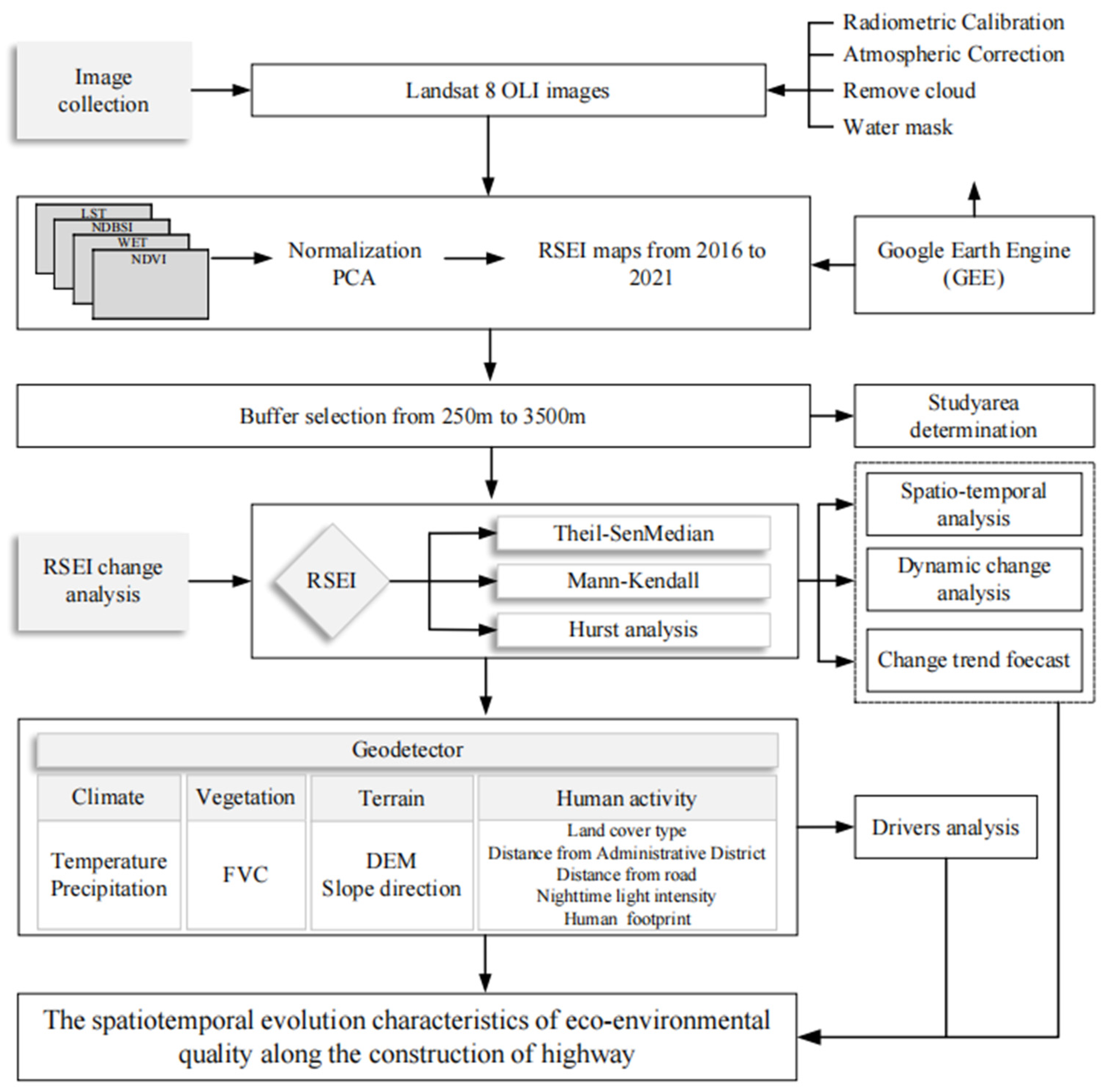

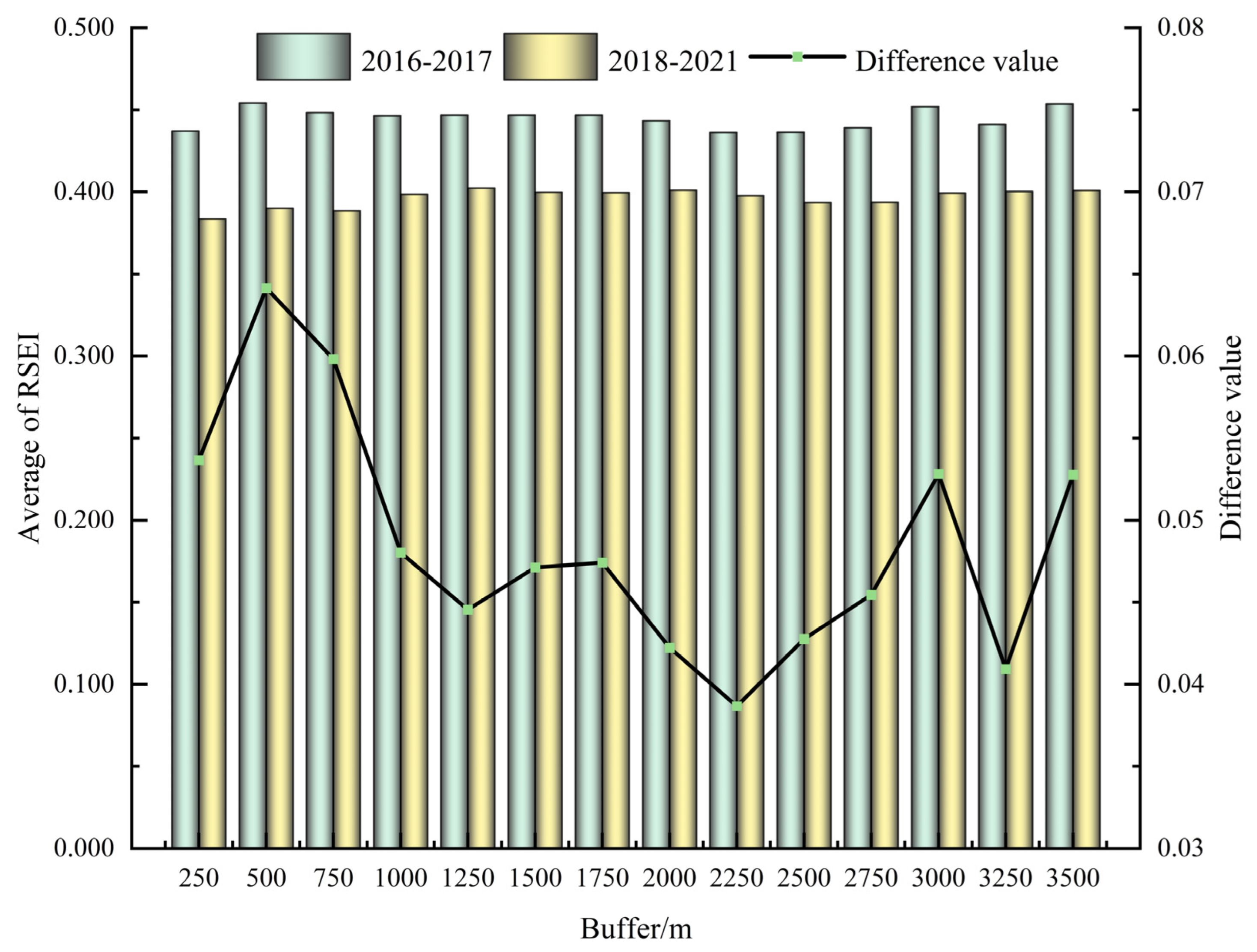




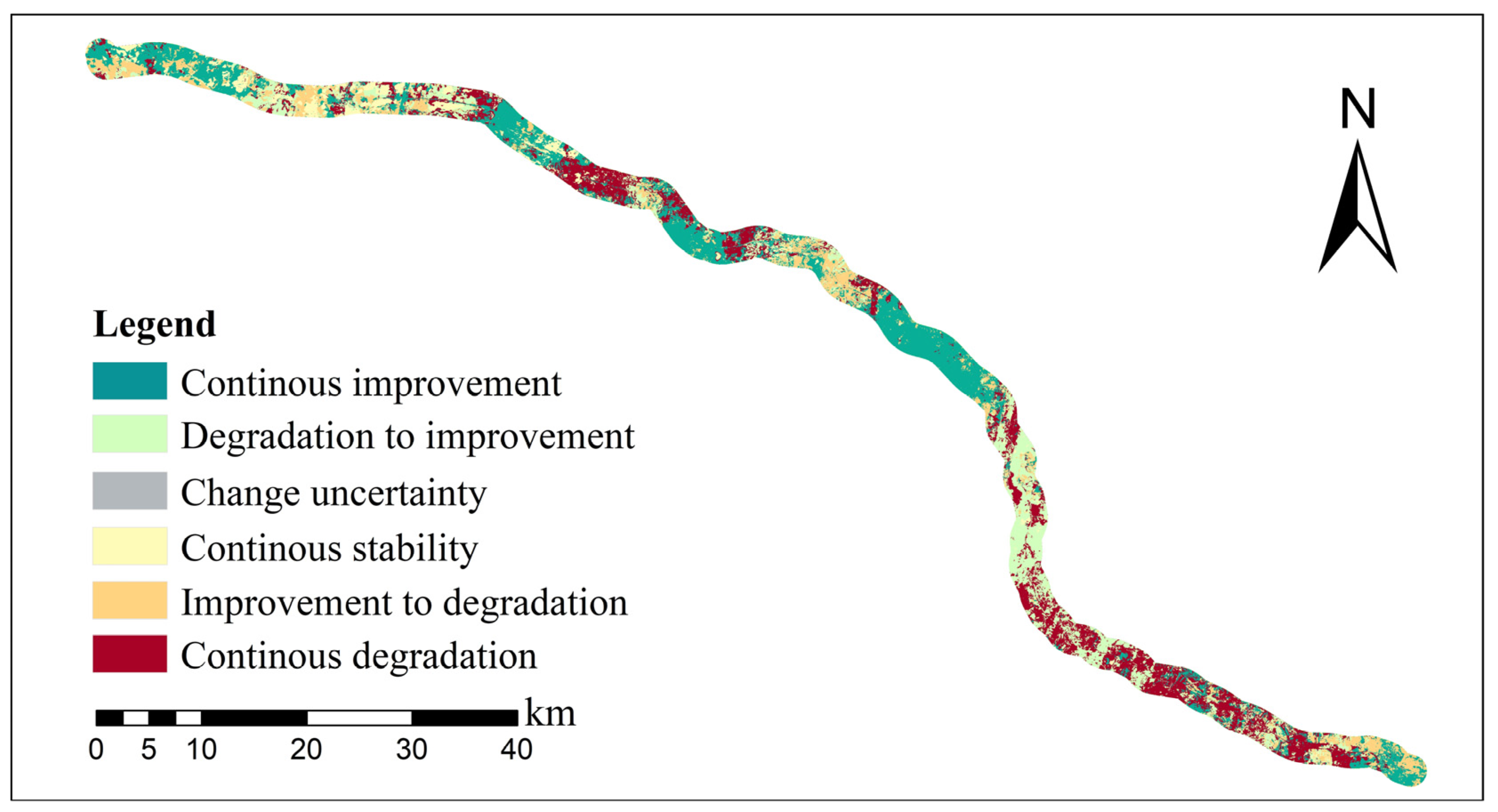
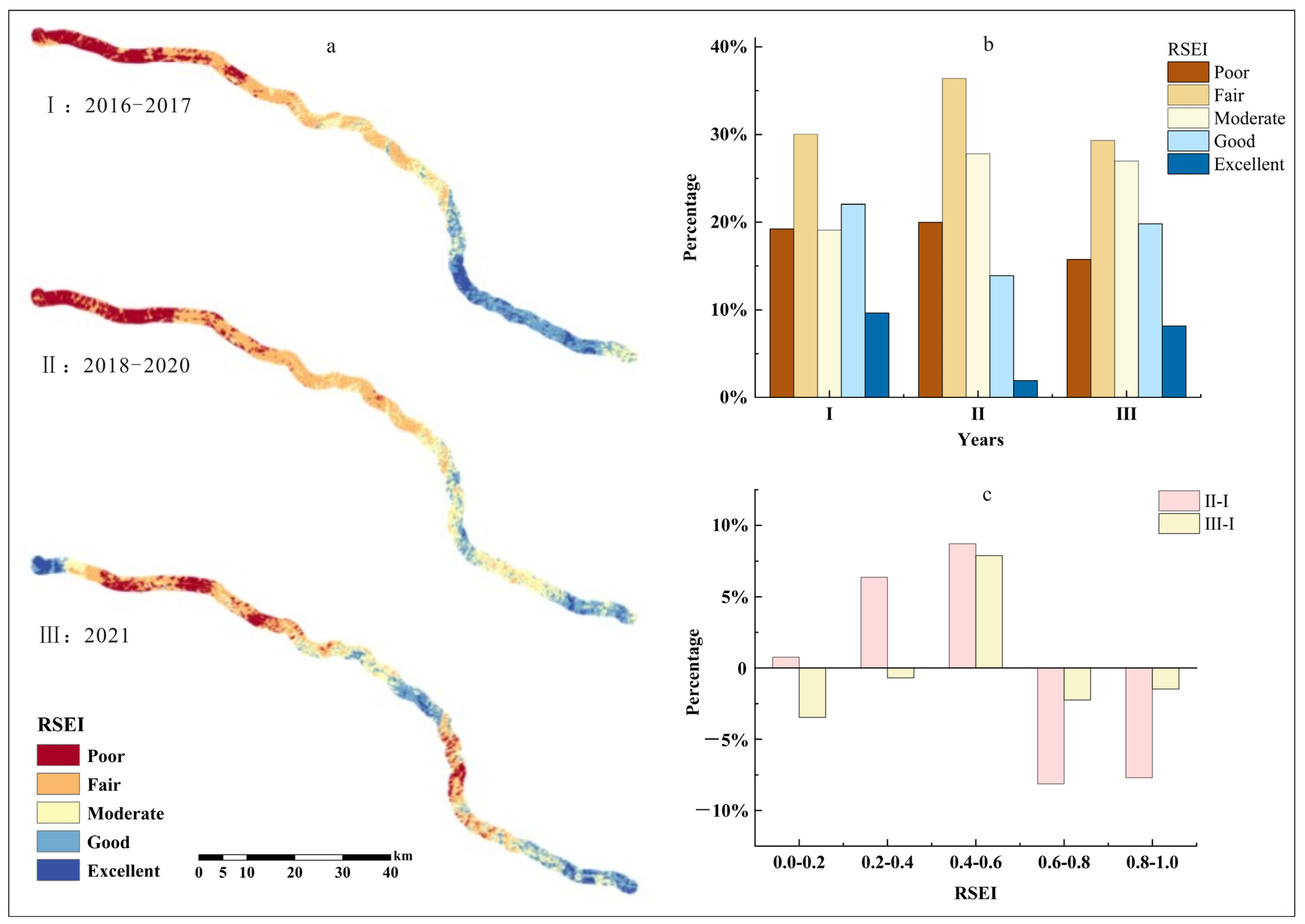
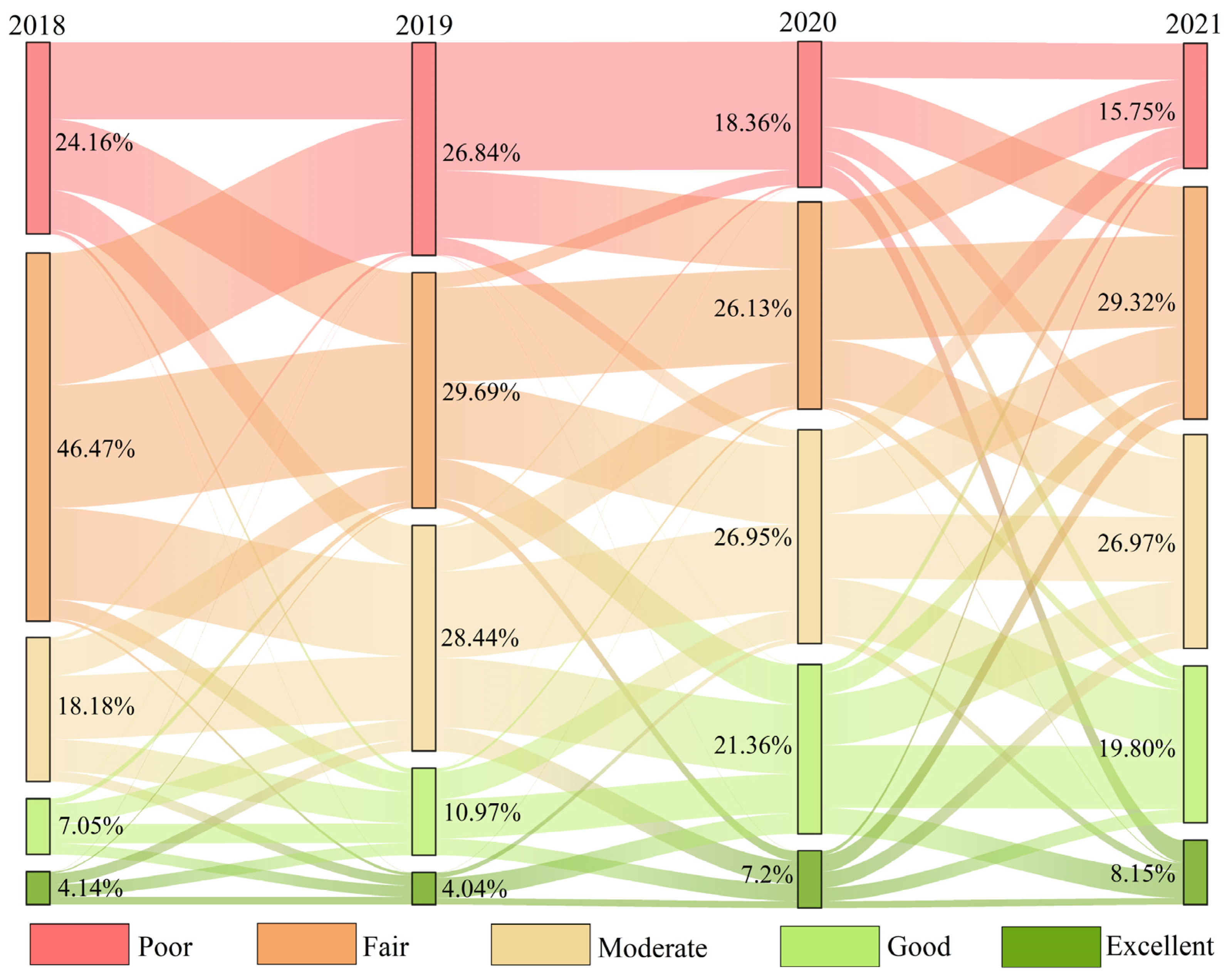
| Type | Name | Source | Time | Resolution |
|---|---|---|---|---|
| Climate | Temperature Precipitation | http://data.cma.cn/ (accessed on 12 January 2023) | 2018, 2020 | 250 m |
| Vegetation | FVC | https://data.tpdc.ac.cn/home (accessed on 15 January 2023) | 2018, 2020 | 250 m |
| Terrain | DEM | https://www.gscloud.cn (accessed on 17 January 2023) | 2010 | 30 m |
| Slope direction | Acquired through DEM data | |||
| Human activity | Land cover type | http://doi.org/10.5281/zenodo.4417809 (accessed on 18 January 2023) | 2018, 2020 | 30 m |
| Road network | http://www.download.geofabrik.de/ (accessed on 23 January 2023) | 2018, 2020 | / | |
| Administrative district station | ||||
| Nighttime light intensity | https://www.ngdc.noaa.gov/eog/download.html (accessed on 22 March 2024) | 2018, 2020 | 500 m | |
| Human footprint | https://www.x-mol.com/groups/li_xuecao/news/48145 (accessed on 23 March 2024) | 2018, 2020 | 1000 m |
| Indicators | Calculation Methods | Indicator Description |
|---|---|---|
| NDVI | The description of each variable is shown in the articles [31,32]. | |
| WET | The description of each variable is shown in the articles [17,33,34]. | |
| NDBSI | The description of each variable is shown in the articles [35,36,37]. | |
| LST | The description of each variable is shown in the articles [38,39]. |
| RSEI | 2016 | 2018 | 2021 | |||
|---|---|---|---|---|---|---|
| Area/km2 | Percent/% | Area/km2 | Percent/% | Area/km2 | Percent/% | |
| Poor (0–0.2) | 80.61 | 12.39 | 157.55 | 24.22 | 102.64 | 15.78 |
| Fair (0.2–0.4) | 177.70 | 27.32 | 302.55 | 46.51 | 191.17 | 29.39 |
| Moderate (0.4–0.6) | 205.45 | 31.58 | 118.08 | 18.15 | 175.35 | 26.96 |
| Good (0.6–0.8) | 130.53 | 20.07 | 45.64 | 7.02 | 128.32 | 19.73 |
| Excellent (0.8–1) | 56.22 | 8.64 | 26.68 | 4.10 | 53.04 | 8.15 |
| Year | Temperature | Precipitation | FVC | DEM | Slope Direction | Land Cover Type | Distance from Road | Distance from Administrative District | Nighttime Light Intensity | Human Footprint | |
|---|---|---|---|---|---|---|---|---|---|---|---|
| q | 0.0327 | 0.4847 | 0.2358 | 0.5006 | 0.0434 | 0.0994 | 0.0138 | 0.2839 | 0.0259 | 0.0517 | |
| 2018 | p | 0.0000 | 0.0000 | 0.0000 | 0.0000 | 0.0000 | 0.0000 | 0.0000 | 0.0000 | 0.0000 | 0.0000 |
| q rank | 8 | 2 | 4 | 1 | 7 | 5 | 10 | 3 | 9 | 6 | |
| q | 0.1402 | 0.6791 | 0.4842 | 0.6925 | 0.0623 | 0.0672 | 0.0262 | 0.5242 | 0.0955 | 0.0799 | |
| 2020 | p | 0.0000 | 0.0000 | 0.0000 | 0.0000 | 0.0000 | 0.0000 | 0.0000 | 0.0000 | 0.0000 | 0.0000 |
| q rank | 5 | 2 | 4 | 1 | 9 | 8 | 10 | 3 | 6 | 7 |
Disclaimer/Publisher’s Note: The statements, opinions and data contained in all publications are solely those of the individual author(s) and contributor(s) and not of MDPI and/or the editor(s). MDPI and/or the editor(s) disclaim responsibility for any injury to people or property resulting from any ideas, methods, instructions or products referred to in the content. |
© 2024 by the authors. Licensee MDPI, Basel, Switzerland. This article is an open access article distributed under the terms and conditions of the Creative Commons Attribution (CC BY) license (https://creativecommons.org/licenses/by/4.0/).
Share and Cite
Hu, Y.; Yang, X.; Gao, X.; Zhang, J.; Kang, L. Analysis of Spatio-Temporal Evolution and Driving Factors of Eco-Environmental Quality during Highway Construction Based on RSEI. Land 2024, 13, 504. https://doi.org/10.3390/land13040504
Hu Y, Yang X, Gao X, Zhang J, Kang L. Analysis of Spatio-Temporal Evolution and Driving Factors of Eco-Environmental Quality during Highway Construction Based on RSEI. Land. 2024; 13(4):504. https://doi.org/10.3390/land13040504
Chicago/Turabian StyleHu, Yanping, Xu Yang, Xin Gao, Jingxiao Zhang, and Lanxin Kang. 2024. "Analysis of Spatio-Temporal Evolution and Driving Factors of Eco-Environmental Quality during Highway Construction Based on RSEI" Land 13, no. 4: 504. https://doi.org/10.3390/land13040504
APA StyleHu, Y., Yang, X., Gao, X., Zhang, J., & Kang, L. (2024). Analysis of Spatio-Temporal Evolution and Driving Factors of Eco-Environmental Quality during Highway Construction Based on RSEI. Land, 13(4), 504. https://doi.org/10.3390/land13040504






